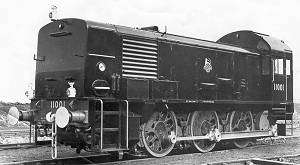British Rail 11001
11001 was one of the first British Railways diesel locomotives, built in 1949 at British Railways' Ashford Works. It was designed by O. V. S. Bulleid when he was Chief Mechanical Engineer of the Southern Railway. It was powered by a Paxman RPH Series 1 engine, capable of delivering 500 brake horsepower (370 kW) at 1,250 rpm. It was driven via a Vulcan-Sinclair fluid coupling to an SSS (synchro-self-shifting) Powerflow gearbox. The gearbox provided three forward and reverse gears in either high or low range, with top speed ranging from 5 mph (8 km/h) in 1st gear, low range up to 36 mph (58 km/h). It had an 0-6-0 wheel formation, driven by rods from a rear jackshaft on the final drive, and with Bulleid's favoured BFB wheels.
| British Rail 11001 | |||||||||||||||||||||||
|---|---|---|---|---|---|---|---|---|---|---|---|---|---|---|---|---|---|---|---|---|---|---|---|
 11001 | |||||||||||||||||||||||
| |||||||||||||||||||||||
| |||||||||||||||||||||||
| |||||||||||||||||||||||
| |||||||||||||||||||||||
Its main duties were on branch lines and shunting, working dwindling goods services on the Caterham line during the 1950s, [1]. It was allocated to Norwood Shed, but also had been photographed in Swindon.
It was withdrawn in August 1959 and cut up at Ashford Works in December.
Oddly, the locomotive's controls were laid out as in a steam locomotive, perhaps because there were at that time few drivers with experience of driving diesel engines. There are no known photographs of the interior.
In fiction
Dennis and Norman, from Thomas & Friends, are based on the 11001 diesel locomotive.
References
- Spence 1986, p. 115.
- Spence, Jeoffry (1986). The Caterham Railway. The Oakwood Press. ISBN 978-0-85361-325-1. Archived from the original on 17 July 2011. Retrieved 24 April 2007.CS1 maint: ref=harv (link)
External links
- "Paxman Rail Traction Diesel Engines". Richard Carr's Paxman History pages.
- "Bulleid's Diesel-mechanical Shunter '11001'". Building Bulleid's Locos.